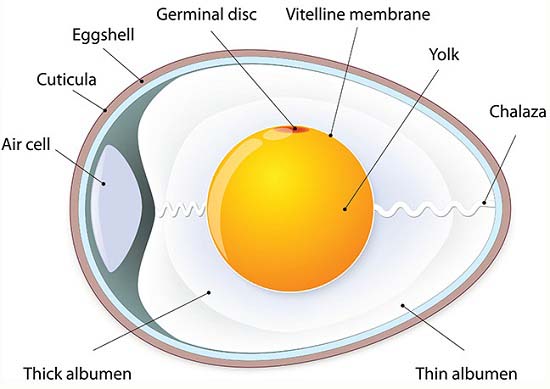
- Shell
- Forms 10-12% of the whole egg content
- Made of calcium and phosphorus
- Protects the inner egg contents
- Shell membrane
- Made of inner and outer membranes
- Lining of the egg shell
- Constitutes 1 % of the total egg content
- Albumen (egg white)
- About 55-60% of the total egg content
- It is divided into chalaza, thick and thin albumen.
- Chalaza holds the egg yolk in position.
- Albumen serves as food for the chick.
- Yolk
- 30-33% of the total egg content
- Supply embryo with nutrients
- Germinal disc
- The embryo which develops into a chick if fertilized
- Vitelline membrane
- Gives the yolk its round shape
- Air sac
- Keeps the egg fresh by allowing gaseous exchange
- Provides oxygen for the embryo
Egg Candling
- This is the practice of determining the internal qualities of an egg by examining it against a light source.
Procedure
- The egg is placed on a hole made on a .cardboard box
- This is called a candling box
- A source of light is placed in the box directly under the egg
- The observer then looks through the egg against the source of light below
-
- Abnormalities on and within the egg can be seen through the translucent shell
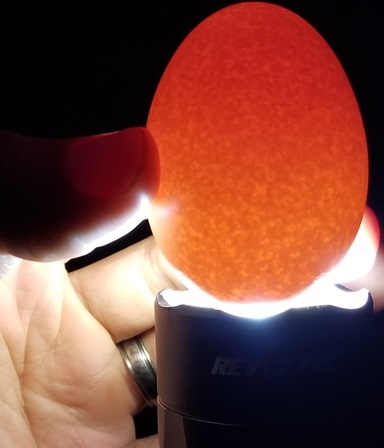
Practical egg candling
Incubation
- Involves the provision of fertile eggs with the proper condition for embryonic development.
Selection of Eggs for Incubation
- Should be fertile
- Should be of medium size about 55- 60gms in weight
- Should have smooth shell
- Should be oval shaped
- Should not be cracked
- Eggs should be clean to ensure that pores are open
- Should not have abnormalities such as blood spots, meat spots and double yolk
- Eggs should not be more than 5 days old.
- Eggs should be fresh that is collected within one week
- Internal egg qualities can be determined through the egg candling process.
Methods of Incubation
Natural Incubation
- This involves the use of a broody hen which sits on the eggs to provide them with conditions necessary for hatching.
- Takes 20-21 days.
- The hen is given about 10-15 eggs.
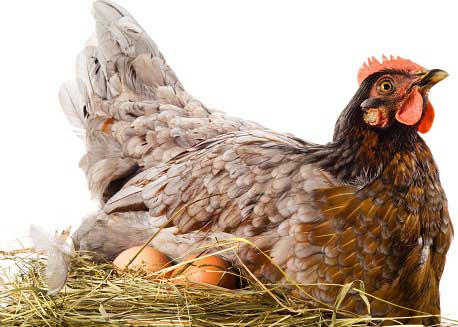
Natural Incubation
Signs of Broodiness in Poultry
- Tendency to sit on an egg after laying
- Moulting of the hen
- Making some noise at the laying nests
- Feathers are raised
- It becomes aggressive when disturbed
- It stops laying
Preparation and Management of Natural Incubation
- The hen is given "China eggs" to sit on to induce broodiness.
- When broody the hen should be provided with a nesting nest or a saucershaped nest scooped on the ground.
- The nest shall be lined with soft bedding and fertile eggs provided.
- The eggs are set in the evening or night.
- The bird is dusted to control external parasites.
- The hen is allowed t hour outside to feed and exercise everyday.
- Broken eggs should be removed immediately.
- The hen should not be disturbed.
Advantages of Natural Incubation
- It is cheap
- High hatchability.
- Low risk involved.
- Useful in small scale production.
- Less skill is required.
- Less laborious.
Disadvantages of Natural Incubation
- Egg production is low because the hen will not lay eggs during incubation.
- It is not possible to plan when to incubate.
- If the hen dies the eggs will be destroyed.
- If the hen deserts the eggs or refuses to sit on them the farmer will incur losses.
- Only few chicks can be hatched at a time by one hen.
- Diseases and parasites could easily be transmitted to the chicks.
Artificial Incubation
This is the use of artificial device known as an incubator for hatching eggs.
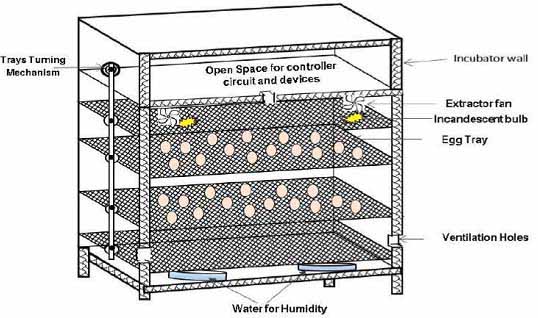
Artificial Incubator
Conditions Necessary for Artificial Hatching of Eggs
- Temperature - maintain at 37.5°C - 39.4°C throughout to control the rate of embryonic development of the chick. High or low temperatures are lethal.
- Ventilation - Good air circulation.
- Carbon dioxide: oxygen ratio maintained at 0.03% : 21 %
- Relative humidity - Maintained at 60%
- High humidity leads to marshy chicks
- low humidity the chick may stick to the shell
- Turning of Eggs
- Done 3-4 times a day to facilitate uniform distribution of heat for uniform development of chick.
- Turn slowly 180° clockwise along the axis to avoid breaking the blood vessels
- Some incubators have automatic turning mechanism
- Cleanliness - cleaning and disinfecting the incubator with formaldehyde solution
Advantages of Artificial Incubation
- It facilitates large scale production of chicks
- Incubators are always ready when needed
- Artificial incubation leads to higher egg production because broodiness in the hens is not required, so there is more time for laying eggs
Disadvantages of Artificial Incubation
- High initial capital in buying an incubator
- High level of management and attention is required
- It is not economical for only a small number of eggs
- High risks involved in turning the eggs
Brooding and Rearing of Chicks
- Brooding is the rearing of day old chicks upto 8 weeks old for the layer chicks and 2 weeks for the broiler chicks.
- For successful brooding the source of the chicks should be considered
Sources of Chicks
The following factors should be considered
- The reputation of the supplier (hatchery).
- Time taken by the chicks in transit.
- Proper sexing and breed identification.
Brooding
Natural Brooding
- A hen is allowed to take care of the chicks
- She provides them with warmth and security
- She stays with the chicks for 8 weeks and then rejects them
Advantages of Natural Brooding
- It is cheap
- Less labour is needed
- Suitable for small scale
Disadvantages of Natural Brooding
- Not possible to produce large numbers of chicks
- The hen goes off laying during brooding time
- Only possible when a broody hen is available
Artificial Brooding
- The chicks are raised artificially in a structure known as a brooder until they are 8 weeks old
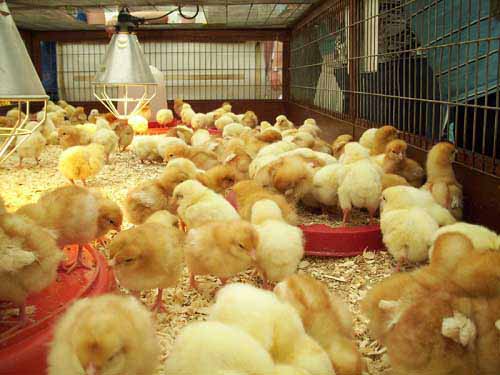
Artificial Chicken Brooder
Brooder Requirements
- Temperature - should be about 35°C in the 15th week and reduced to 21°C by the 8th week.
- Litter - wood shavings which are capable of absorbing 60% moisture without showing wetness should be used.
- Space confinement - Done by use of hard-boards which are about 25Cm high and form a circular space. A space of 1m2 for 25 chicks is required.
- Feeders and waterers - should be enough for the chicks and evenly distributed in the brooder.
- Ventilators - windows should be enough to allow proper air circulation but direct draught should be avoided.
Types of Heaters in the Brooder
- Electric heaters - one ordinary bulb 100 watts can raise 30 chicks
- One infrared bulb 240 watts can raise 100 chicks
- Kerosene burners - Hurricane lamps can raise 100 chicks
- Charcoal burners - these are specially made jikos with heat deflectors
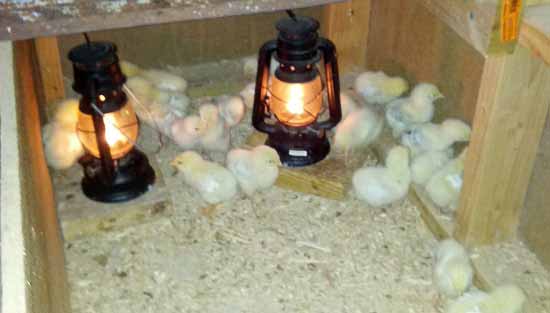
Kerosene Burner in Brooders
Brooder Management
Preparation Before Chicks Arrive
- Start 2-3 days before arrival.
- The brooder house should be cleaned to remove old litter and then disinfected
- New litters 5-1Ocm high should be put in and covered with absorbent materials/news papers
- Equipment should be cleaned, disinfected and tested to make sure that they are working
- The brooder is lit about 6 hours before the chicks arrive
- Feed and water should be placed into shallow containers
- Brooder space should be confined with a hard board to prevent chicks straying far from the source of heat
Management After Arrival of the Chicks
- Chicks are placed in the brooder during the day to familiarize with the brooder.
- If chicks arrive stressed and weak they should be given glucose solution in the waterers.
- In case the heat source is charcoal burners they should be covered with wire mesh.
- Feed chicks with chick mash which is later mixed with growers mash as the chicks grow.
- Clean water should be provided and changed regularly.
- Constant attention should be given to the chicks for the first 2 weeks.
- Any vices should be checked and controlled.
- Any dead chicks should be removed as soon as seen.
- Ventilation should be used to control the temperature and humidity in the brooder.
- Constant disinfection is required at the entrance to avoid diseases.
- Brooder space should be increased as the chicks grow.
- Debeaking should be done at 10 days old.
- Vaccination against diseases such as Gumboro after 2 weeks, New Castle at 3-4 weeks and fowl typhoid at 7 weeks.
- Dusting to control external parasites.
- Growers' mash should be introduced gradually at 7 weeks old.
- Chicks are removed from the brooder when they are 8 weeks old.
- On average the chick uses about 1.5KG - 2.2kg of chick mash by the time it is 8 weeks old.
Temperature Control in the Brooder
If the brooder temperatures are low the following should be done:
- Brooder space is reduced
- Heaters are increased
- Ventilators are closed
If the brooder temperatures are too high the following should be done:
- Brooder space is increased
- Heaters should be reduced
- Ventilators should be opened
Management of the Growers
- The growers are birds at the age of 9 weeks to the point of lay that is at 18 weeks.
- Growers should be fed on growers' mash.
- By this time the growers should be occupying the main poultry house.
- Sick birds should be isolated and treated.
- A foot bath for constant disinfection should be placed at the entrance.
- Each bird is fed 115 gms per day of growers' mash.
- Greens and soluble grit should also be provided.
- Clean water should be provided all the time (adilibitum).
- Drenching against internal parasites should be done by adding a dewormer into the water.
- Vermins should be controlled.
- Litter should be kept dry by turning.
- Vaccination should be done as required.
- Layer pullets require dimly lit house.
Management of the Layers
- Layers' mash should be introduced at 18 weeks and increased gradually.
- The birds start laying at 18-21 weeks.
- The birds should be vaccinated against New Castle and fowl typhoid.
- Enough floor space roosts, feeders and waterers should be provided.
- Each hen should be given 120gms per day of layers' mash.
- Clean water should be provided adlibitum.
- Eggs should be collected twice a day at noon and in the evening.
- Green leaves should be provided to keep the birds busy thus preventing cannibalism and improve the yellow colour of the yolk.
- Grains should be given in addition to the layers' mash at the rate of 65gms per bird per day.
- Soluble grit or oyster shells should be provided at all times for efficient digestion and strong shelled eggs.
- Layers should be fed according to their body weight and the rate of egg production for example a 70kg bag should feed 100 layers for 4-5 days.
- Enough laying nests should be provided at least 1 per 5 layers.
- The laying boxes should be dimly lit to reduce egg eating.
- Debeaking should be done when necessary.
- Broken eggs and dead birds should be disposed off properly.
- The non-layers and cannibals should be culled.
Management of the Broilers
- Broilers are table birds kept for meat production.
- They have high growth rates or high feed conversion ratio.
- The objective is to produce a kilogram of quality poultry meat from less than two kg of broiler feed.
- The broiler chick requires special broiler feed from day old to 4 weeks of age.
- Broiler starters' mash or crumbs should be fed.
- This contains coccidiostat, high level of protein, vitamins and trace elements for early growth.
- From 4 weeks to 8 weeks they are given broiler follow-on mash or pellets.
- This feed contains high level of metabolisable energy to ensure a good cover of subcutaneous fat in the finished broiler.
- From 8 weeks until slaughter finisher pellets should be given to increase the size.
- Adequate clean water should be provided at all times (adlibitum).
- High level of hygiene should be maintained to reduce mortality rate.
- Birds should be dusted with appropriate pesticides to control external parasites.
- Deworming should be done routinely.
- Vaccination against common diseases should be done.
- Dead birds should be disposed off properly.
- Broilers should be kept under deep litter system, the house should be well ventilated and well lit.
Poultry Rearing Systems
a) Extensive
b) Semi intensive
c) Intensive systems.
Extensive
Free Range
- Birds are set free throughout the day to fend for themselves.
- Birds are confined in night shelters for the night.
- There is no supplementation.
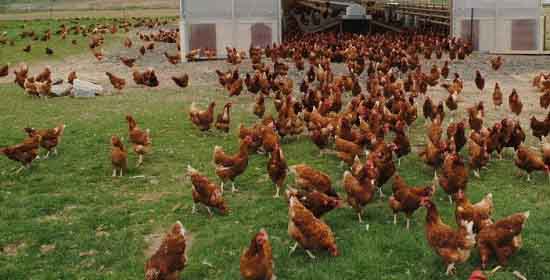
Free range poultry farming - Photo Courtesy
Advantages
- Birds eat insects and green leaves therefore less feed is required.
- Cheap method.
- Cannibalism and egg eating are reduced since the birds are not crowded.
- Manure is evenly spread in the runs.
- Low labour requirement.
- Birds get plenty of exercises thus helping to keep in good health.
- No need to provide grit as birds pick it from the soil.
Disadvantages
- More land is required if a farmer wants to rear many birds.
- Birds can be stolen or eaten by predators.
- Eggs get lost in the vegetation or stolen.
- Eggs get dirty.
- Difficult to determine layers from non-layers.
- Birds get easily infected with diseases and parasites of the area.
- Breeding programme is not easy to follow.
- Birds can destroy crops where perimeter fencing is not constructed.
- Low productivity per unit area.
Semi-Intensive
Fold System
- Birds are confined in small portable structures called folds.
- A fold measures 3.5M long, 1.5M wide and 1.5M height.
- 1/3 of the fold is roofed while the rest is enclosed with wire mesh.
- Birds get plenty of sunlight.
- Birds get fresh grass as the fold is moved to new grounds.
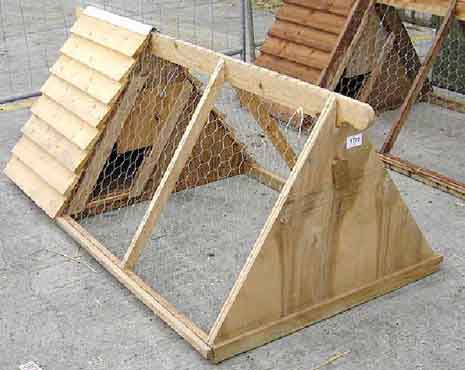
A traditional poultry fold - Photo Courtesy
Advantages
- Manure is evenly spread in the field.
- Less feed is used because birds eat grass.
- Reduces build up of parasites and diseases since the fold is moved often.
- Birds are protected from predators.
Disadvantages
- Few birds are kept per fold.
- It is laborious since the folds are moved from one place to the other.
- Individual egg production record is difficult to keep.
- The fold does not last long because of high frequency of handling.
- The return per unit area of land is low.
Intensive System
Deep Litter System
- Birds are confined in a house throughout their life.
- The floor of the house is made up of litter which accumulates over time.
- Enough feeders, waterers and laying boxes are provided depending on the number of birds and space available.
- Movable roosts and perches made of timber frames should be provided in the house.
- Stress and vices should be watched closely and controlled.
- Eggs should be collected as frequently as possible to prevent dirt and egg eating.
- The house should be dimly lit.
- The floor space requirement should be 1m2 per 2-3 birds.

Deep Litter System - Photo Courtesy
Advantages
- High stocking rate per unit area of land.
- Low labour requirement.
- Fast accumulation of manure.
- There is control of feeding, egg production and movement of birds.
- Safety of the birds is guaranteed from predators.
- No loss of eggs.
- Useful method when rearing breeding stock.
- Regular cleaning of the house is not necessary since the litter absorbs the droppings.
- Easy collection of eggs.
Disadvantages
- High incidence of cannibalism like egg eating, feather plucking and toe pecking.
- Pests and disease causing organisms accumulate in the litter.
- Individual records of the birds are not possible.
- May be difficult to find litter.
- Eggs become dirty if laid on the floor.
- Feeders and waterers may be contaminated by the litter.
- The system encourages broodiness in hens.
- High infestation of diseases if the management is below standard.
- If there is a disease outbreak, it can spread very quickly throughout the house due to the communal housing.
- High cost of building deep litter house.
Battery Cage System
- Birds are confined in cages which are placed in the poultry house.
- The cages are made of wire mesh
- Each cage contains 1-3 birds.
- Water and feed troughs together with eggs trays are fitted along the front side of the cages.
- The floor of the cages should be slanting to allow the eggs to roll out of the cages.
- Droppings from the cages fall from behind for easy cleaning.
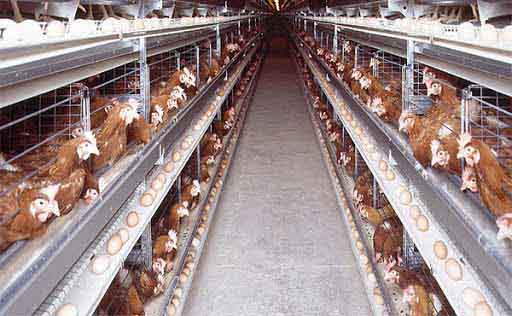
Battery Cage System - Photo Courtesy
Advantages
- Records are easily kept therefore culling is easy.
- Birds do not become broody.
- More eggs are collected due to restricted movement of the hens and complete control of egg eating.
- Tender meat is obtained from the culls because the muscles have not been toughened much.
- Handling is easier than in the other systems and individual attention to hens is given.
- Stocking rate is very high.
- Vices are greatly reduced.
- Eggs are clean because hens do not step on them.
- The system can easily be mechanised.
- Birds do not contaminate the food and water.
- Sick birds can be detected easily and isolated for treatment.
- Wire floors prevent re-infestation of parasitic worms and coccidiosis.
- No bullying during feeding.
- Low labour requirement
Disadvantages
- Initial costs for cages, equipment and house are excessively high.
- Requires high level of management.
- Higher maintenance costs where automation is used.
- Birds may get fatigue due to lack of exercises thus lowering productivity.
- In case of disease outbreak, spreading is very fast.
- Birds develop bruises on combs, breasts and toes as they stick their necks out-to feed and walk in the cages.
- Not useful when rearing breeding stock and the rearing of broilers.
- Cannot be used for brooding young chicks.
Stress and Vices in Chicken
- Stress is a condition imposed on the birds making them disturbed and uncomfortable.
- Stress reduces production and brings about poor performance.
- Vices are habits developed by animals.
- These affect production and health of the birds.
- Usually they are bad habits.
Cause of Stress in Poultry
- Sudden changes in routine management.
- Presence of strangers in the poultry house.
- Presence of animals and vermins.
- Too much noise.
- Constant and poor handling.
- Sudden weather changes.
- Disturbance of the pecking order.
- Overcrowding
- Poor hygiene.
- Disease and pest attack.
- Lack of food and water.
Control of Stress
- Poultry house should be kept quiet and constructed away from noise.
- Poultry house should be insulated to maintain constant temperatures.
- Parasites and diseases should be controlled.
- Change in routine management should be gradual.
- Enough feed and water should be provided
Vices
- Feather pecking.
- Cannibalism (toe and vent pecking).
- Egg eating.
Pecking and Cannibalism
Situation where birds peck at each other resulting in death or injury.
The effects of
pecking and cannibalism are :
- Feather and body growth rate IS reduced.
- Loss of birds due to death may result from cannibalism.
- Culling rate is increased (economic loss).
- The appearance of the carcass is spoiled thereby reducing its market value
The causes of cannibalism are:
- Overcrowding in the house.
- High temperatures in the poultry house making the birds uncomfortable.
- Too bright light.
- External parasite infestation.
- Inadequate and incorrect feeding.
- Idleness of the birds.
- Greediness of the birds.
- Disturbances of the pecking order.
- Prolapses of the rectum which occurs once in a while.
- Bright light in the lying boxes.
The preventive measures are:
- Ample spacing should be provided on the floor, feeders, waterers and laying boxes.
- Overheating should be avoided during brooding.
- The house should be dimly lit for the layers.
- Laying nests should be darkened and above the ground.
- Dusting should be done to control external parasites.
- Provide enough balanced ration.
- Birds should be kept busy.
- New/strange birds should not be allowed in the house.
Egg Eating
A vice influenced by the following:
- Presence of broken or soft shelled eggs.
- Idleness of the birds.
- Inadequate laying nests.
- Mineral deficiencies.
- Bright light in the laying nests.
- Greediness of the birds.
The preventive measures are:
- Eggs should be collected regularly.
- Laying boxes raised above the ground.
- Laying boxes should be darkened.
- Birds should be given balanced ration.
- Debeaking should be done as need be.
- Birds should be kept busy with greens.
- Birds should be kept according to age groups
- Injured birds should be isolated and treated.
Marketing of Poultry Products
- Poultry products include eggs and meat
Marketing of Eggs
- Eggs are delicate and perishable foods and have the highest value when fresh
The factors considered when sorting out and grading eggs for the market include
-
Size/weight of the egg - large eggs fetch high prices than small ones. The average weight should be about 57gms.
-
Shape of the egg - The normal egg shape is oval, with a broad end and a narrow end.
-
Cleanliness - Consumers prefer clean eggs.
-
Colour of the shell - Brown eggs are popular with the consumers.
-
Candling qualities - candling is done to determine freshness of the eggs and presence of any other egg abnormalities.
-
Shell texture - should be smooth and without cracks
Poultry Meat
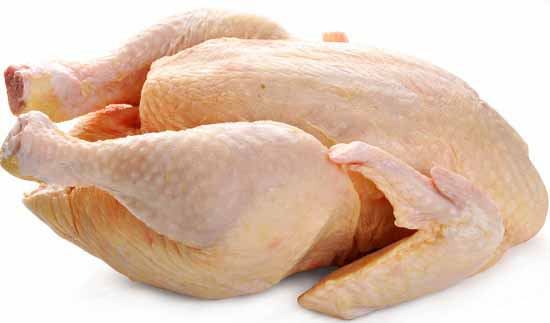
Raw Chicken Meat - Photo Courtesy
- Broilers are slaughtered at the age of 1-2.5months old with a life weight of 1.5-2KGS.
- The birds are killed and dressed in a clean way before being wrapped in clean bags ready for sale.
- The meat is sold in hotels and restaurants.
- Whole birds can be sold live in local markets










